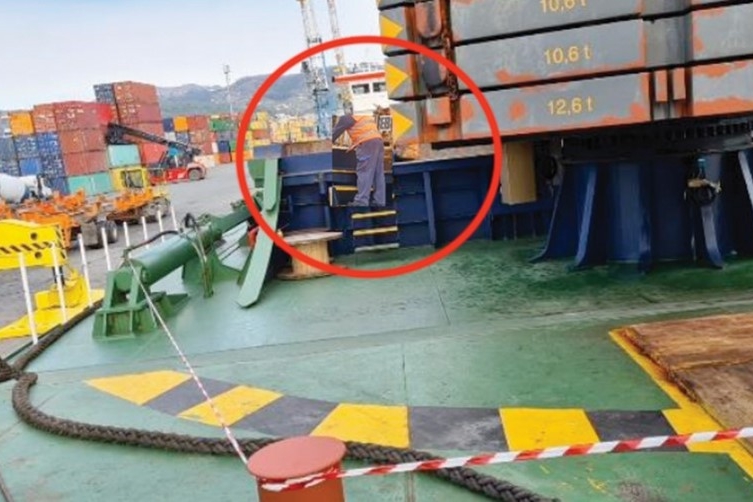While symbolic barriers are better than nothing, it would be best to invest in physical barriers. The Nautical Institute gives this advice in its latest Mars Report in which a dredger’s master accessed the area where a crane was in operation and was crushed between the crane and cargo hold as a result.
The Nautical Institute gathers reports of maritime accidents and near-misses. It then publishes these so-called Mars Reports (anonymously) to prevent other accidents from happening. A summary of this incident:
A small hopper dredger equipped with a deck grab crane was occupied with the refurbishment of a port breakwater. The work involved lifting boulders from the cargo hold with the deck grab crane and positioning them at the breakwater. The chief engineer, who maintained direct contact with the crane operator via a portable radio, was on the bridge overseeing the operation.
The master, who was new to the ship and had joined only two weeks earlier, was occupied with administrative tasks. At one point, he decided to go on deck and check on some recent maintenance work at the bow. He took the access way on starboard side of the cargo hold to reach the forecastle (the port side access way had been cordoned off.) During this time, the crane operator, who was placing one boulder in position at the breakwater, noticed the master in proximity of the paint locker.
Also read: Gantry crane improvisation leads to one fatality
After checking on the maintenance, the master decided to check the status of the boulders in the cargo hold. He climbed the starboard stairs to the cargo hold and looked inside the cargo hold. At this time, the crane operator had the crane’s boom in line with the cargo hold and was picking up a boulder from the hold. Within a matter of seconds, the crane turned clockwise towards the breakwater, entrapping the master between the body of the crane and the cargo hold coaming.
The crane operator heard a scream and turned the crane back towards the cargo hold. He immediately noticed the master lying on deck. He raised the alert and the chief engineer, who was on the bridge, called for shore medical assistance.
The master was admitted to the local hospital; he had suffered a massive hematoma, muscle laceration of the right abdominal wall, and a fractured vertebrae. The victim was discharged from hospital the next day and received further medical treatment once home.
Investigation findings
The investigation found, among others, that although access to the forecastle from the port side of the cargo hold had been cordoned off by a physical barrier system (a chain), access to the forecastle from the starboard side was unobstructed. Black and yellow “hazardous area” markings were painted in a semi-circle on the deck around the crane, extending from port to starboard. But paint markings are a symbolic barrier system and therefore require one’s interpretation to be effective (as opposed to a physical barrier system).
Also read: Crew member crushed by tween deck pontoon
Advice from The Nautical Institute
- While symbolic barriers are better than nothing, their effectiveness is debatable. Physical barriers are much better. And an excellent complement to physical barriers are administrative barriers documented in a vessel’s safety management system (SMS).
- Mars Report 201851 documents a very similar accident, but one with more serious consequences as the victim, new to the ship, died of his injuries. In that case, not only was there an absence of physical barriers, but no danger warnings were present.
Also read: Alcohol consumption contributory factor in crane crush fatality
Mars Reports
This accident was covered in the Mars Reports, originally published as Mars 202224, that are part of Report Number 356. A selection of this Report will also be published in SWZ|Maritime’s July-August 2022 issue. The Nautical Institute compiles these reports to help prevent maritime accidents. That is why they are also published on SWZ|Maritime’s website.
More reports are needed to keep the scheme interesting and informative. All reports are read only by the Mars coordinator and are treated in the strictest confidence. To submit a report, please use the Mars report form.
Picture: A composite reenactment of the situation – the red and white danger tape was not present at the time of the accident.








